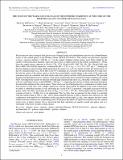THE STATE OF THE WARM AND COLD GAS IN THE EXTREME STARBURST AT THE CORE OF THE PHOENIX GALAXY CLUSTER (SPT-CLJ2344-4243)
Author(s)
McDonald, Michael A.; Swinbank, Mark; Edge, Alastair C.; Wilner, David J.; Veilleux, Sylvain; Benson, Bradford A.; Hogan, Michael T.; Marrone, Daniel P.; McNamara, Brian R.; Wei, Lisa H.; Bayliss, Matthew B.; Bautz, Marshall W.; ... Show more Show less
DownloadMcDonald-2014-The state of the war.pdf (1.473Mb)
PUBLISHER_POLICY
Publisher Policy
Article is made available in accordance with the publisher's policy and may be subject to US copyright law. Please refer to the publisher's site for terms of use.
Terms of use
Metadata
Show full item recordAbstract
We present new optical integral field spectroscopy (Gemini South) and submillimeter spectroscopy (Submillimeter Array) of the central galaxy in the Phoenix cluster (SPT-CLJ2344-4243). This cluster was previously reported to have a massive starburst (~800 M ☉ yr–1) in the central, brightest cluster galaxy, most likely fueled by the rapidly cooling intracluster medium. These new data reveal a complex emission-line nebula, extending for >30 kpc from the central galaxy, detected at [O II]λλ3726, 3729, [O III]λλ4959, 5007, Hβ, Hγ, Hδ, [Ne III]λ3869, and He II λ4686. The total Hα luminosity, assuming Hα/Hβ = 2.85, is L [subscript Hα] = 7.6 ± 0.4 ×1043 erg s–1, making this the most luminous emission-line nebula detected in the center of a cool core cluster. Overall, the relative fluxes of the low-ionization lines (e.g., [O II], Hβ) to the UV continuum are consistent with photoionization by young stars. In both the center of the galaxy and in a newly discovered highly ionized plume to the north of the galaxy, the ionization ratios are consistent with both shocks and active galactic nucleus (AGN) photoionization. We speculate that this extended plume may be a galactic wind, driven and partially photoionized by both the starburst and central AGN. Throughout the cluster we measure elevated high-ionization line ratios (e.g., He II/Hβ, [O III]/Hβ), coupled with an overall high-velocity width (FWHM [greater than and approx. equal to] 500 km s[superscript –1]), suggesting that shocks are likely important throughout the interstellar medium of the central galaxy. These shocks are most likely driven by a combination of stellar winds from massive young stars, core-collapse supernovae, and the central AGN. In addition to the warm, ionized gas, we detect a substantial amount of cold, molecular gas via the CO(3-2) transition, coincident in position with the galaxy center. We infer a molecular gas mass of M[subscript h2] = 2.2 ± 0.6 × 1010 M ☉, which implies that the starburst will consume its fuel in ~30 Myr if it is not replenished. The L IR/ M[subscript h2] that we measure for this cluster is consistent with the starburst limit of 500 L ☉/M ☉, above which radiation pressure is able to disperse the cold reservoir. The combination of the high level of turbulence in the warm phase and the high L IR/ M[subscript h2] ratio suggests that this violent starburst may be in the process of quenching itself. We propose that phases of rapid star formation may be common in the cores of galaxy clusters, but so short-lived that their signatures are quickly erased and appear only in a subsample of the most strongly cooling clusters.
Date issued
2014-03Department
MIT Kavli Institute for Astrophysics and Space ResearchJournal
Astrophysical Journal
Publisher
Institute of Physics/American Astronomical Society
Citation
McDonald, Michael, Mark Swinbank, Alastair C. Edge, David J. Wilner, Sylvain Veilleux, Bradford A. Benson, Michael T. Hogan, et al. “THE STATE OF THE WARM AND COLD GAS IN THE EXTREME STARBURST AT THE CORE OF THE PHOENIX GALAXY CLUSTER (SPT-CLJ2344-4243).” The Astrophysical Journal 784, no. 1 (February 27, 2014): 18. © 2014 American Astronomical Society.
Version: Final published version
ISSN
0004-637X
1538-4357